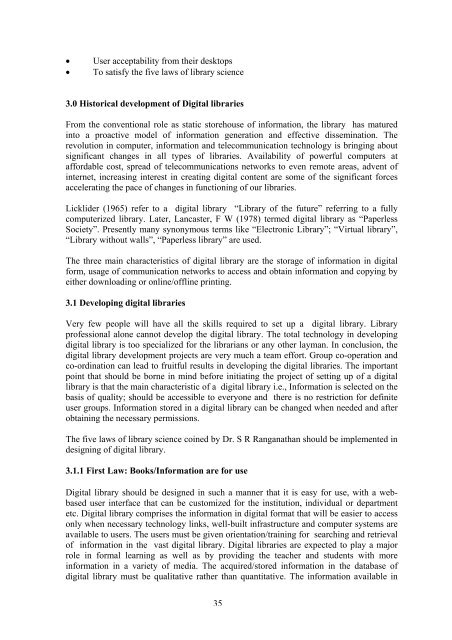7 - Indira Gandhi Centre for Atomic Research
7 - Indira Gandhi Centre for Atomic Research
7 - Indira Gandhi Centre for Atomic Research
You also want an ePaper? Increase the reach of your titles
YUMPU automatically turns print PDFs into web optimized ePapers that Google loves.
• User acceptability from their desktops<br />
• To satisfy the five laws of library science<br />
3.0 Historical development of Digital libraries<br />
From the conventional role as static storehouse of in<strong>for</strong>mation, the library has matured<br />
into a proactive model of in<strong>for</strong>mation generation and effective dissemination. The<br />
revolution in computer, in<strong>for</strong>mation and telecommunication technology is bringing about<br />
significant changes in all types of libraries. Availability of powerful computers at<br />
af<strong>for</strong>dable cost, spread of telecommunications networks to even remote areas, advent of<br />
internet, increasing interest in creating digital content are some of the significant <strong>for</strong>ces<br />
accelerating the pace of changes in functioning of our libraries.<br />
Licklider (1965) refer to a digital library “Library of the future” referring to a fully<br />
computerized library. Later, Lancaster, F W (1978) termed digital library as “Paperless<br />
Society”. Presently many synonymous terms like “Electronic Library”; “Virtual library”,<br />
“Library without walls”, “Paperless library” are used.<br />
The three main characteristics of digital library are the storage of in<strong>for</strong>mation in digital<br />
<strong>for</strong>m, usage of communication networks to access and obtain in<strong>for</strong>mation and copying by<br />
either downloading or online/offline printing.<br />
3.1 Developing digital libraries<br />
Very few people will have all the skills required to set up a digital library. Library<br />
professional alone cannot develop the digital library. The total technology in developing<br />
digital library is too specialized <strong>for</strong> the librarians or any other layman. In conclusion, the<br />
digital library development projects are very much a team ef<strong>for</strong>t. Group co-operation and<br />
co-ordination can lead to fruitful results in developing the digital libraries. The important<br />
point that should be borne in mind be<strong>for</strong>e initiating the project of setting up of a digital<br />
library is that the main characteristic of a digital library i.e., In<strong>for</strong>mation is selected on the<br />
basis of quality; should be accessible to everyone and there is no restriction <strong>for</strong> definite<br />
user groups. In<strong>for</strong>mation stored in a digital library can be changed when needed and after<br />
obtaining the necessary permissions.<br />
The five laws of library science coined by Dr. S R Ranganathan should be implemented in<br />
designing of digital library.<br />
3.1.1 First Law: Books/In<strong>for</strong>mation are <strong>for</strong> use<br />
Digital library should be designed in such a manner that it is easy <strong>for</strong> use, with a webbased<br />
user interface that can be customized <strong>for</strong> the institution, individual or department<br />
etc. Digital library comprises the in<strong>for</strong>mation in digital <strong>for</strong>mat that will be easier to access<br />
only when necessary technology links, well-built infrastructure and computer systems are<br />
available to users. The users must be given orientation/training <strong>for</strong> searching and retrieval<br />
of in<strong>for</strong>mation in the vast digital library. Digital libraries are expected to play a major<br />
role in <strong>for</strong>mal learning as well as by providing the teacher and students with more<br />
in<strong>for</strong>mation in a variety of media. The acquired/stored in<strong>for</strong>mation in the database of<br />
digital library must be qualitative rather than quantitative. The in<strong>for</strong>mation available in<br />
35
















